Tax Information
Form 1098-T
Colleges and universities are required to issue Form 1098-T for the purpose of determining a taxpayer’s eligibility for various tax credits and/or deductions under Internal Revenue Code Section 6050S. The 1098-T is provided no later than January 31 of each year and contains payment and scholarship information for the preceding tax year.
Miami University reports payments received for qualified tuition and related expenses (QTRE) in Box 1 on the 1098-T. In addition:
- Data contained on the 1098-T is reported for account activity between January 1 and December 31 of the tax year.
- Students can elect to receive their 1098-Ts electronically by signing up on Heartland ECSI.
- Students will be able to access their 1098-T electronically through BannerWeb beginning on January 31.
- Students who do not select this option will have their 1098-T mailed to their permanent mailing address.
- Students without a listed social security number are encouraged through an email communication to provide it during the fall. However, students are not required to do so.
For more valuable information, including an overview of the 1098-T’s various sections and instructions on how to elect to receive your 1098-T electronically, keep reading. Frequently asked questions are also answered at the bottom of this page.
Understanding the 1098-T
Charges considered qualified tuition and related expenses (QTRE) include:
- Instructional Fee
- General Fee
- Non-Resident Surcharge
- Career Development Fee
- Admission Fee
- Business Course Surcharges
- Special Course Fees/Surcharges
- Market Driven Tuition Charges
- E-Learning Fees
Charges not counted toward qualified tuition and related expenses (QTRE) include:
- Housing
- Food
- Books, Course Materials, Supplies, and Equipment
- MUlaa
- Student Health Insurance
- Student Health Service Charges
- Orientation Fees
- Study Abroad Program/Admin Fees
- Parking Fees/Fines
- Disciplinary Fees
The tax year is considered the calendar year, not the academic year. It is sometimes referred to as the reporting year. All amounts on the 1098-T are based on transactions that occurred during the tax year. For more information, review the descriptions for the 1098-T’s various boxes below.
Box 1 contains payments (with refunds subtracted out) made during the tax year up to, but not in excess of, QTRE charges billed within the same tax year. “Payments” may be from any source, including direct payments, 529 plan payments, all types of financial aid, and private loans/scholarships. Passthrough or point-of-sale payments are not included.
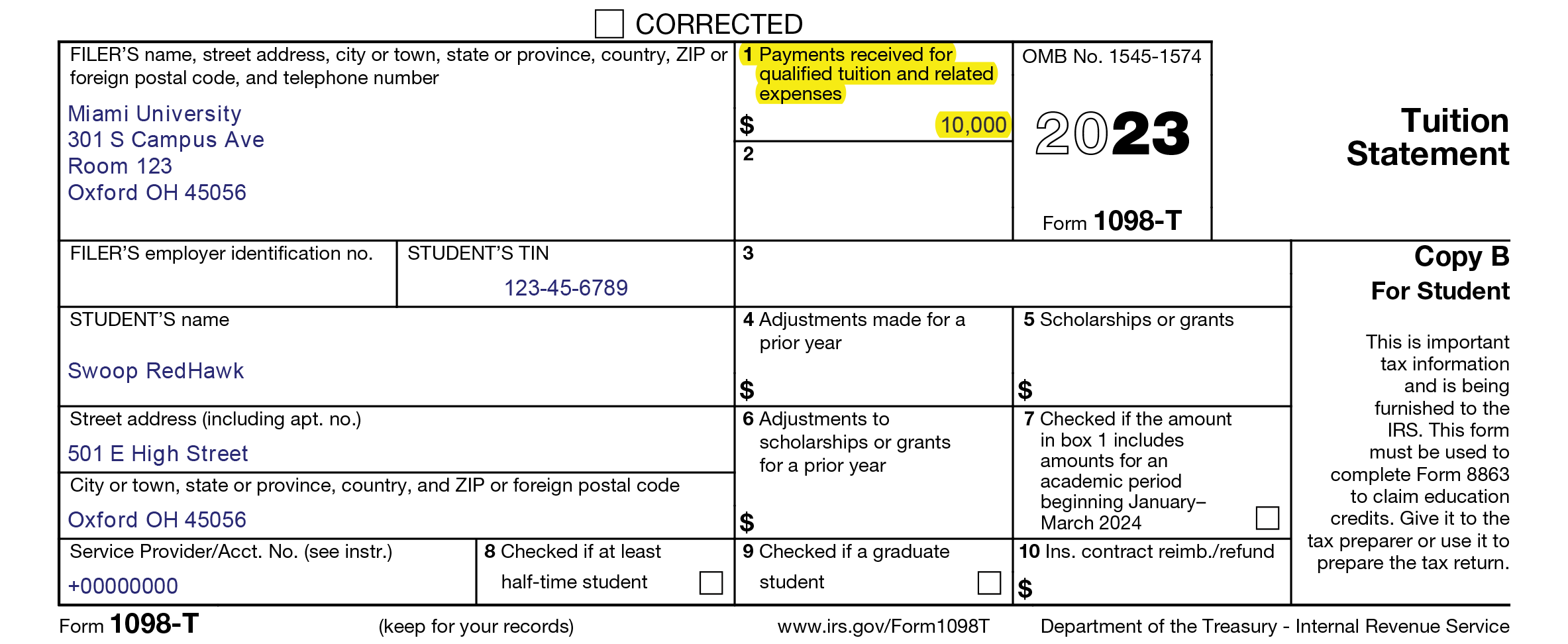
Box 4 contains the net adjustment of charges and payments on any previous year’s 1098-T during the current tax year.
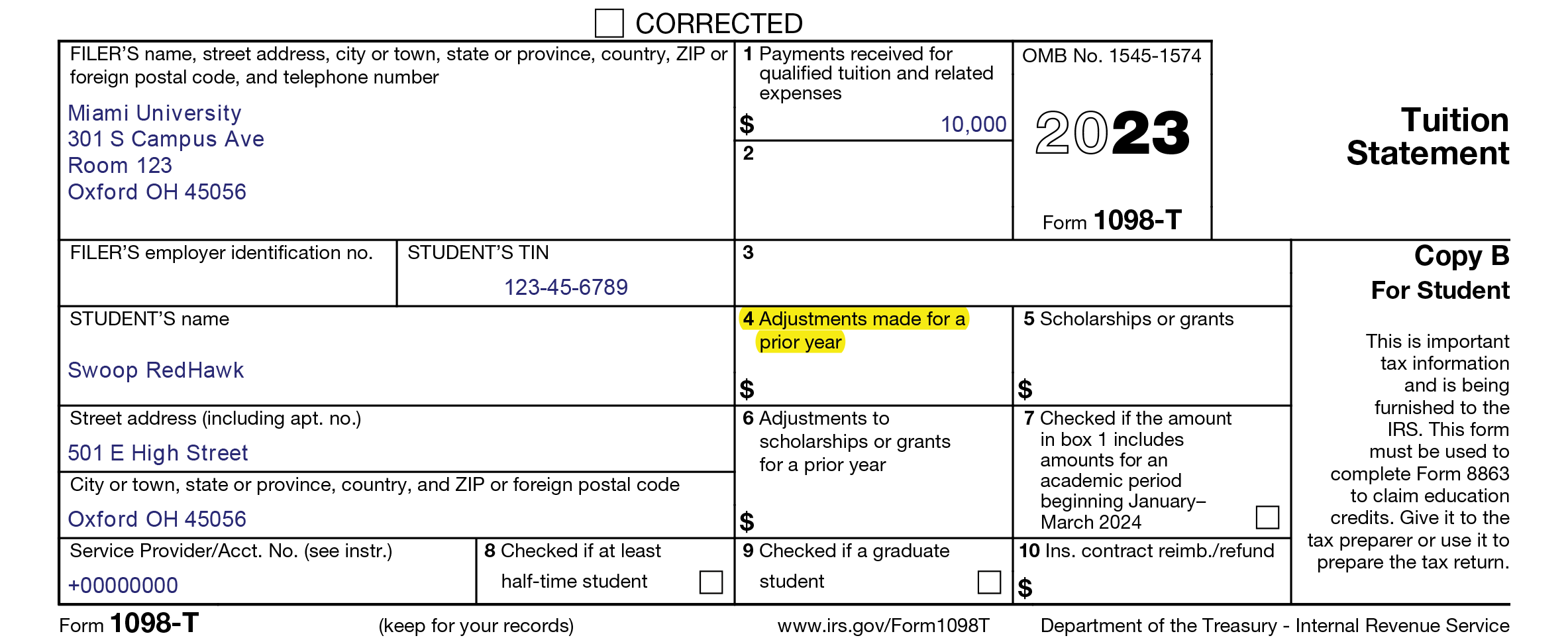
Box 5 contains scholarships, grants, waivers, and third-party payments applied during the tax year.
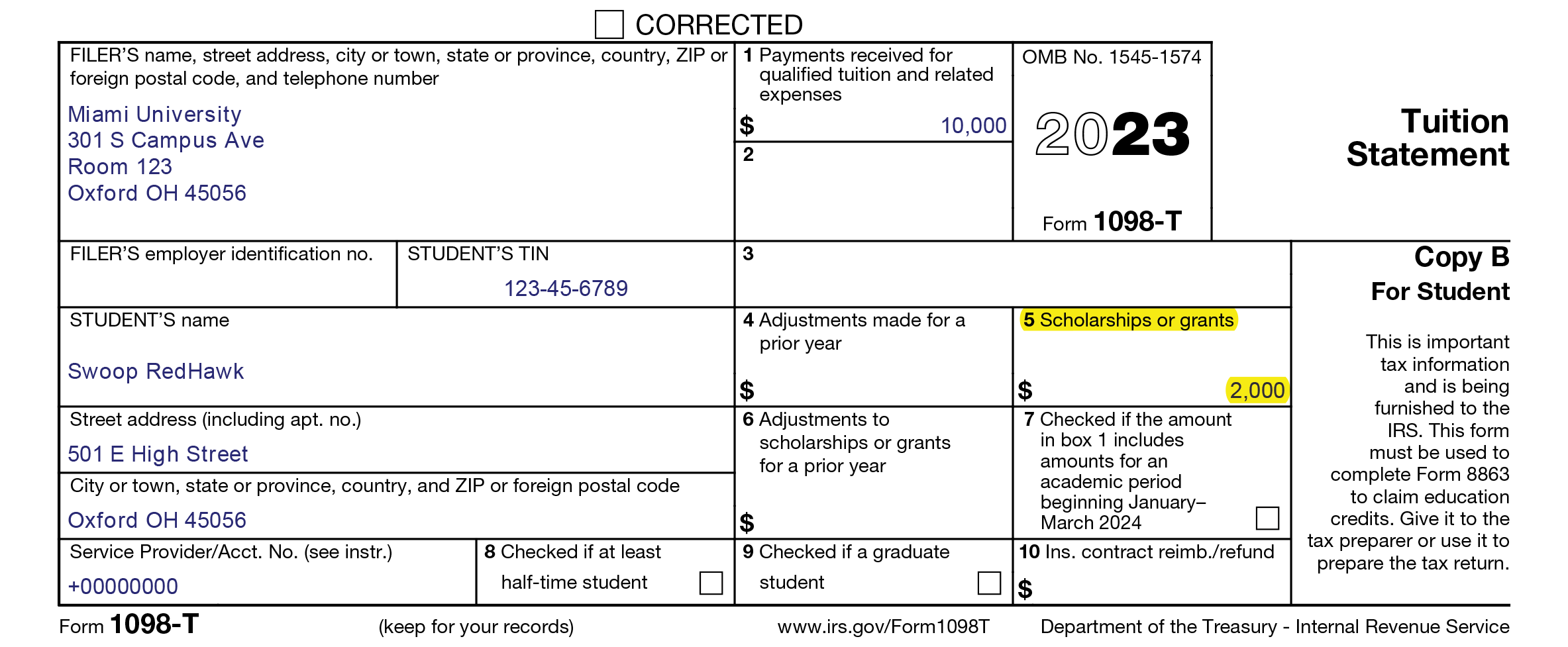
Box 6 contains net adjustments made to any scholarships or grants for any previous year’s 1098-T during the current tax year.
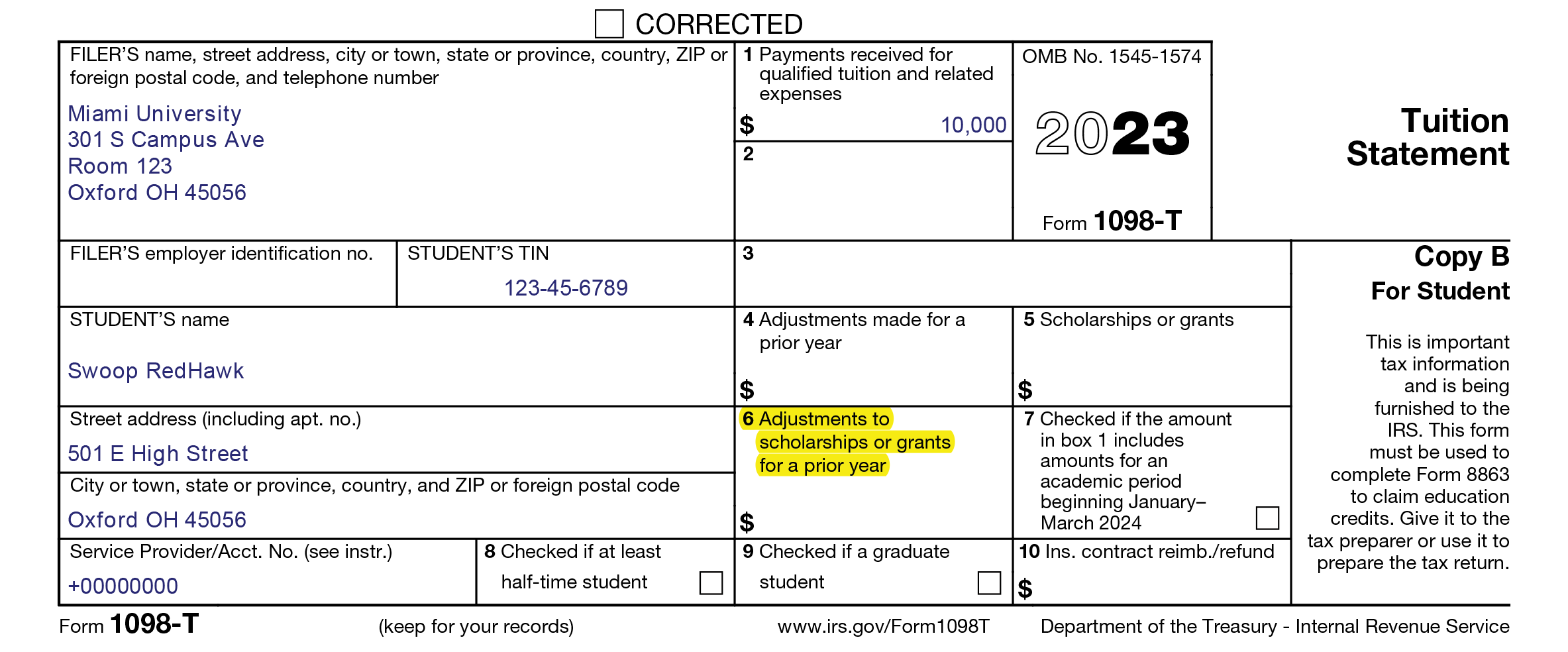
Box 7 is checked if any payments that were made during the tax year are applied to any billed QTRE for an academic period beginning in January through March of the following year.
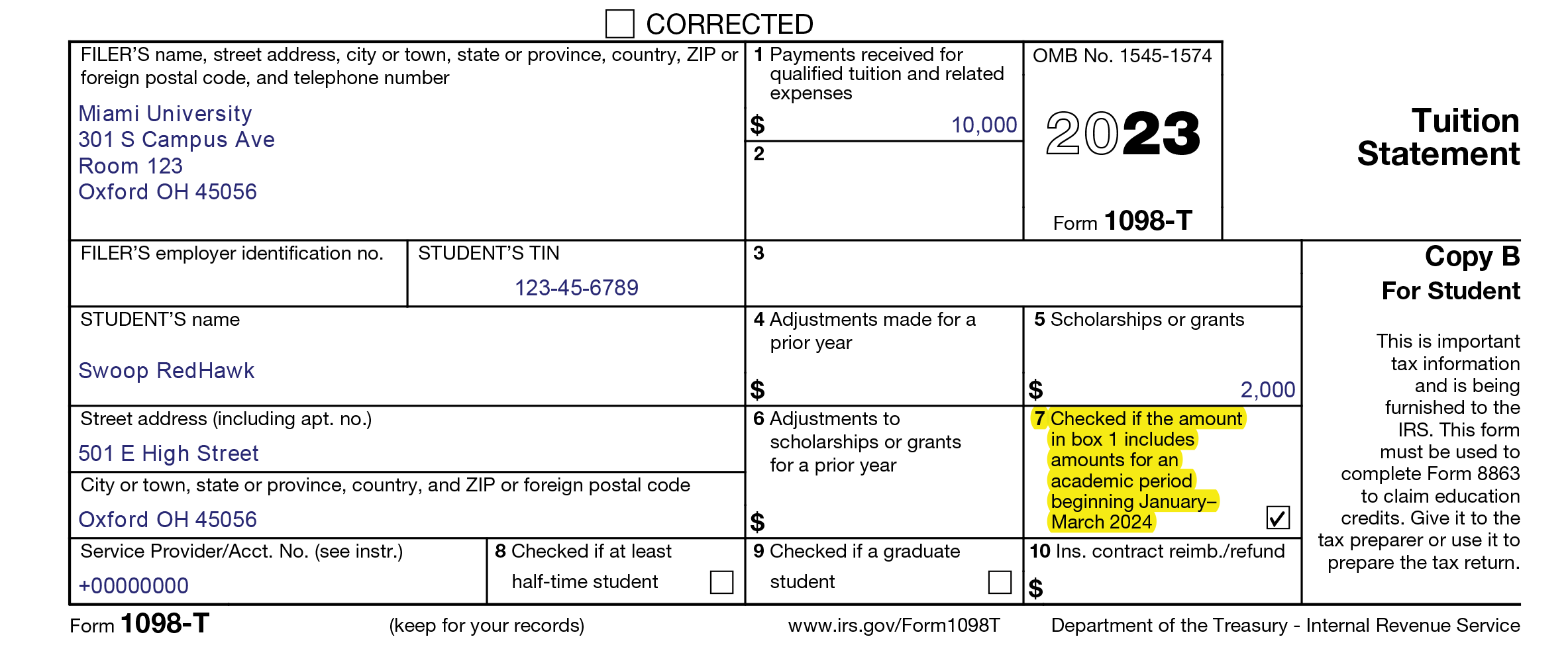
Box 8 is checked if a student was enrolled at least half-time (six credit hours) during the tax year.
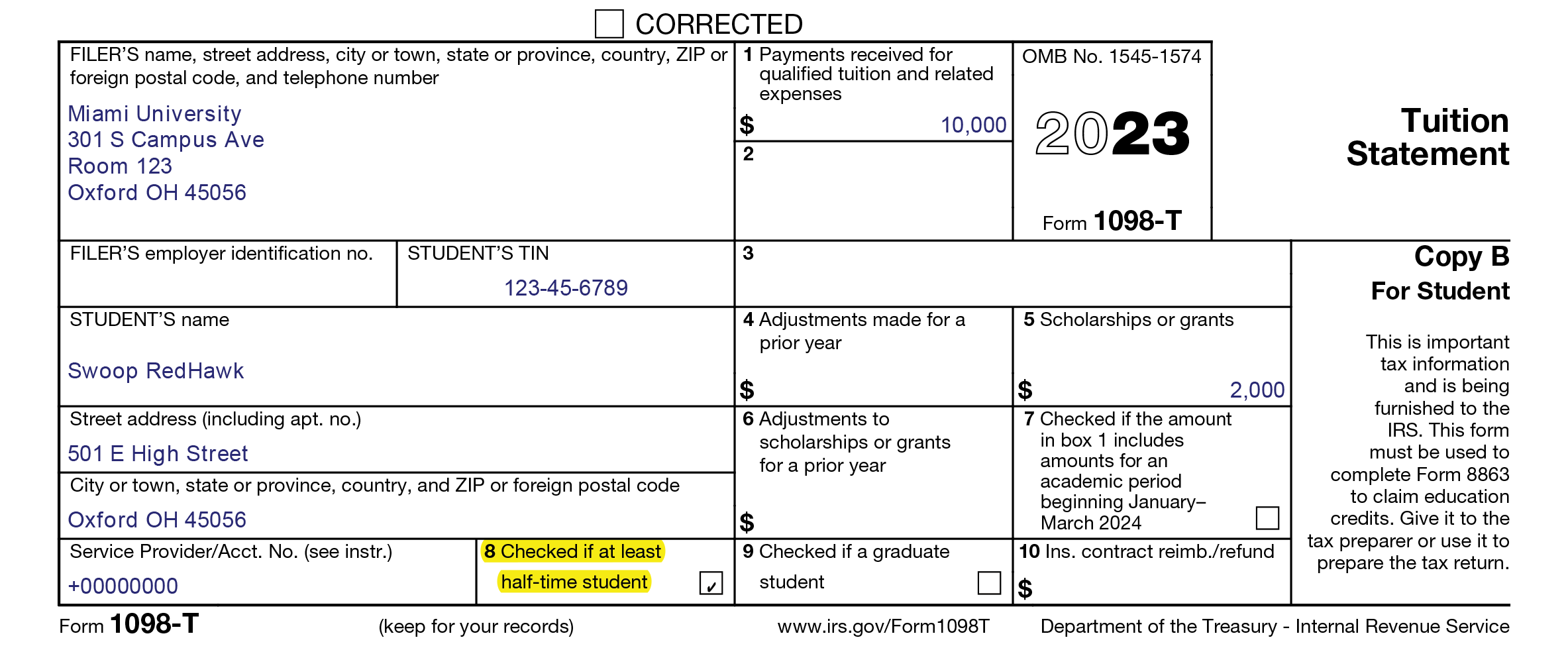
Box 9 is checked if the student was enrolled at the graduate level during the tax year.
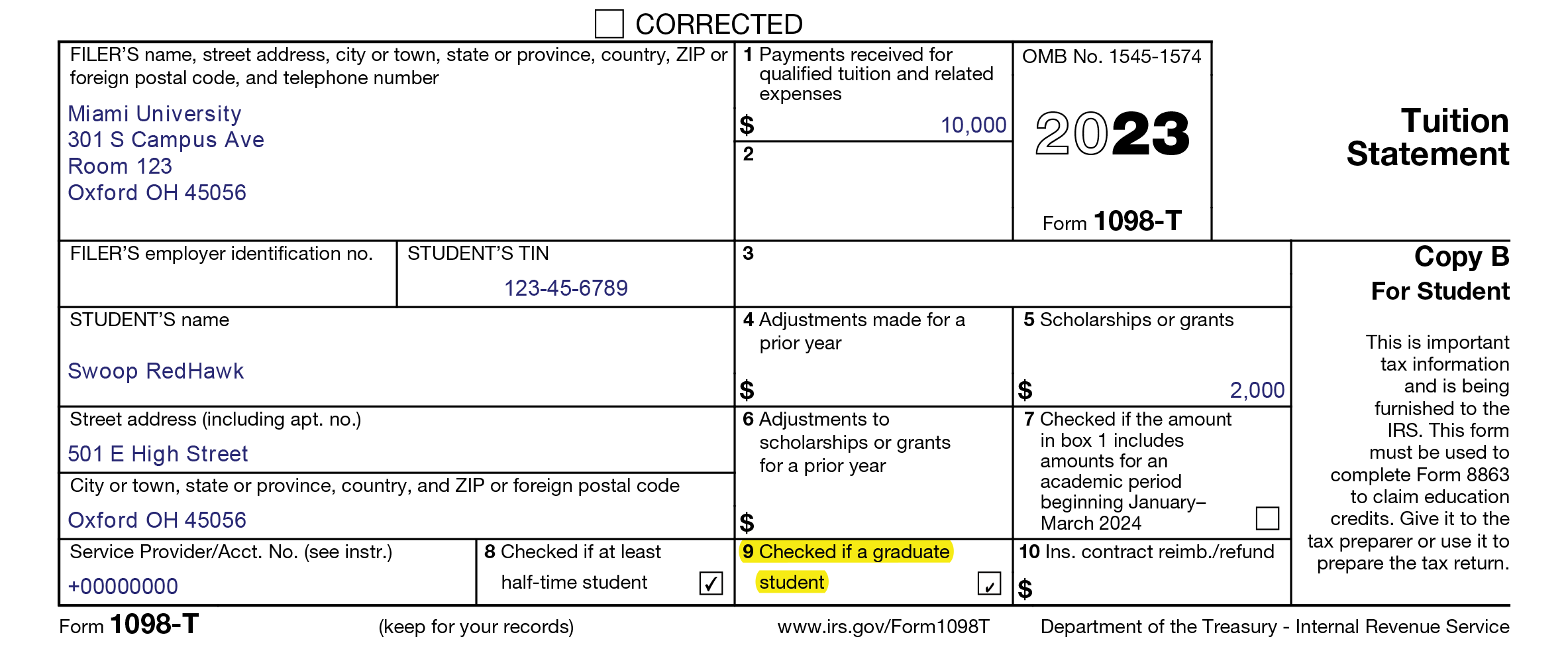
Your Electronic 1098-T
In partnership with Heartland ECSI, Miami offers current and former students the opportunity to receive their 1098-T electronically.
Additional Information
If you would like to receive your 1098-T electronically, complete the 1098-T Electronic Consent for Miami University. You will be asked to provide your Banner ID, name, and email address. Heartland ECSI’s website is a secure website, and Heartland ECSI will not share your private information with anyone. Students have until January 15 of each year to provide consent to receive their 1098-T electronically.
Receiving the 1098-T electronically offers the following benefits:
- Provides access to the form 1098-T earlier than the traditional mailing process.
- Eliminates the chance that the 1098-T will get lost, misdirected, or delayed during delivery, or misplaced once the student receives it.
- Students can receive their 1098-T even while traveling or on assignment away from their home address.
If you elect to receive the electronic 1098-T, no paper statement will be mailed to you. When your statement is ready, an email will be sent to you with instructions on how to access your 1098-T statement online. To protect your privacy, the email will contain no information specific to you or your financial information. If you need assistance, call Heartland ECSI’s 1098-T Hotline at 866-428-1098 or use Heartland ECSI’s online chat feature.
Students can access their 1098-T statement quickly and easily by visiting Heartland ECSI using one of the following methods:
- If you already have a profile with Heartland ECSI, sign in.
- If you have not yet connected your tax statements to your account, you will need to connect them using your Heartland Key. Click the “Connect on Account” button and enter your tax statement Heartland Key.
- If you have not registered a profile, click the “Sign In or Register” button in the upper right side of the page. Complete the registration section to create your profile and then connect your tax account by entering your Heartland Key.
Don’t want to create a profile? No problem. You can view your current tax statement by clicking on the View Your Tax Form link, selecting your school, and entering your first and last name, Social Security Number, and zip code. Be advised you will only be able to view your current tax statement without a profile. If you want to view previous year tax statements, you will need to create a profile.
Current and former students who do not sign up by January 15 to receive an electronic 1098-T will receive a paper 1098-T if eligible. Paper forms will be mailed to the student by January 31 of each year. If you have questions about your paper 1098-T, contact the One Stop for your campus.
If you elect to receive an electronic 1098-T, no paper statement will be mailed to you.
International tax forms pertaining to United States wages that are exempt from federal and state withholding because of tax treaties, non-qualified scholarships covered for international students, honorariums paid to international guests, and certain monies paid to international corporations, should be taken to Payroll Services, located in Room 2, Roudebush Hall.
International tax forms pertaining to the certification of educational charges (amount of tuition and fees paid by the student for specific terms attended) should be taken to the One Stop on your campus.
Tax Resources
We are happy to share these links but do not intend them as tax advice. Questions about taxability, or how to report the 1098-T, must be answered by tax professionals. The One Stop can only answer questions about how the amounts on your 1098-T were calculated.
Frequently Asked Questions
In calculating the 1098-T, all payments from all sources—except passthrough or point-of-sale payments like MULAA, dining dollars, or study abroad administrative or program fees—are calculated up to the QTRE, with any refunds subtracted out. The includes all financial aid—grants, loans, and scholarships—as well as cash payments, 529 payments, third party/sponsored payments, etc.
Box 5 only includes scholarships, grants, exemptions, waivers, and third-party/sponsored payments. Refer to IRS Publication 970 for further information.
When determining your eligibility for education-related tax credits and deductions, you will need to report the amount you paid for qualified tuition and related expenses (QTRE). Your account statements are an accurate source of information for amounts paid, including dates.
As the University cannot provide tax advice, we recommend consulting with a tax professional about additional documentation that you must file on your own behalf. These may be accessed through the student’s online account portal, or requests may be directed to the One Stop. Please note that we are unable to change 1098-Ts unless there is a genuine error or if there is a correction to a SSN/TIN or address.
Attention, Spring Grads!
Box 1 on a spring graduate’s final 1098-T may often contain no (or a lower than expected) amount even if payments were made during the tax year. This is typically because most (or all) of the qualified tuition and related expenses (QTRE) for the spring semester were billed in November/December of the previous tax year. For this reason, they fall in a separate tax year from when the payments were received.
Because payments cannot exceed the amount of QTRE within the same tax year, payments may only be counted up to this amount. This amount may sometimes be zero due to when charges are posted to a student’s account.
Contact the One Stop
The One Stop assists Miami students and authorized family members with billing and payment, financial aid, registration, and student records.
Oxford Campus
Nellie Craig Walker Hall
301 S. Campus Ave.
Oxford, OH 45056
OneStop@MiamiOH.edu
Phone: 513-529-0001
Fax: 513-529-0003
Hamilton Campus
102 Mosler Hall
1601 University Blvd.
Hamilton, OH 45011
RegOneStop@MiamiOH.edu
Phone: 513-217-4111
Fax: 513-785-1807
Middletown Campus
114 Johnston Hall
4200 N. University Blvd.
Middletown, OH 45042
RegOneStop@MiamiOH.edu
Phone: 513-217-4111
Fax: 513-727-3427
Miami Online
Graduate students
OneStop@MiamiOH.edu
Phone: 513-529-0001
Fax: 513-529-0003
Undergraduate students
RegOneStop@MiamiOH.edu
Phone: 513-217-4111
Fax: 513-785-1807